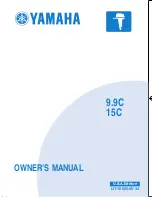UM11057
All information provided in this document is subject to legal disclaimers.
© NXP B.V. 2017. All rights reserved.
User Manual
Rev. 1.0 — 9 June 2017
6 of 14
NXP Semiconductors
UM11057
User Manual
3. Getting
Started
The LPCXpresso845MAX board is pre-programmed with a simple program to blink a user
LED, indicating that the target MCU is running. Connect a micro USB cable from
connector J4 to a host computer or power supply to power up the board and run this
program.
The rest of this section describes how to set up your board for use with MCUXpresso IDE
and/or third party tools.
3.1 Debugger firmware update
The LPCXpresso845MAX board comes pre-programmed with a CMSIS-DAP firmware
image. Early production boards are programmed with firmware based on the mbed
CMSIS-DAP port which requires installation of the mbed serial port driver on Windows
platforms before the board can be used (note that the LPCXpresso845 board is not mbed
enabled). Later boards do not require this driver installation, and it is recommended that
the latest debugger firmware is downloaded onto the board before starting a debug
session. The debugger firmware is available from http://nxp.com/demoboard/om13097
under the Software and Tools tab (look under “Software” download types).
After downloading the debugger firmware image (which will be called firmware.bin), follow
these steps:
1. With the board unpowered, install jumper JP3.
2. Power the board. Using File Explorer (or equivalent on Mac/Linux platforms), look at
the available drives on your system. A device called CRP_DISABLED will appear.
3. Delete the firmware.bin file on the CRP_DISABLED drive.
4. Drag and drop the firmware.bin file you downloaded from nxp.com on to the
CRP_DISABLED drive.
5. Remove JP3, unplug then repower the board.
6. The board should now enumerate on your system - allow 20-30 seconds for this to
complete.
3.2 Using the board with MCUXpresso IDE
Once the board debugger firmware has been installed (as described in
Section 3.1
), to
use the board during a debug session in MCUXpresso IDE, connect to the host computer
then follow the steps below.
Note that MCUXpresso IDE has built-in knowledge of the LPC84x part family, so does not
require any SDK installation steps. Follow the steps below to build and run a simple
example from the LPC84x Code Bundles provided by NXP.
Code Bundles for the LPC8xx family are included in the MCUXpresso IDE installation.
These can also be downloaded from nxp.com (in case of any updates between IDE
releases): https://www.nxp.com/LPC800-Code-Bundles. (Note that MCUXpresso IDE has
a link to the Code Bundle Page in the Help -> Additional Resources menu).
1. Open a new workspace in the IDE.
2. In the Quickstart panel of the IDE, click in “Import project(s) from the file system”

















